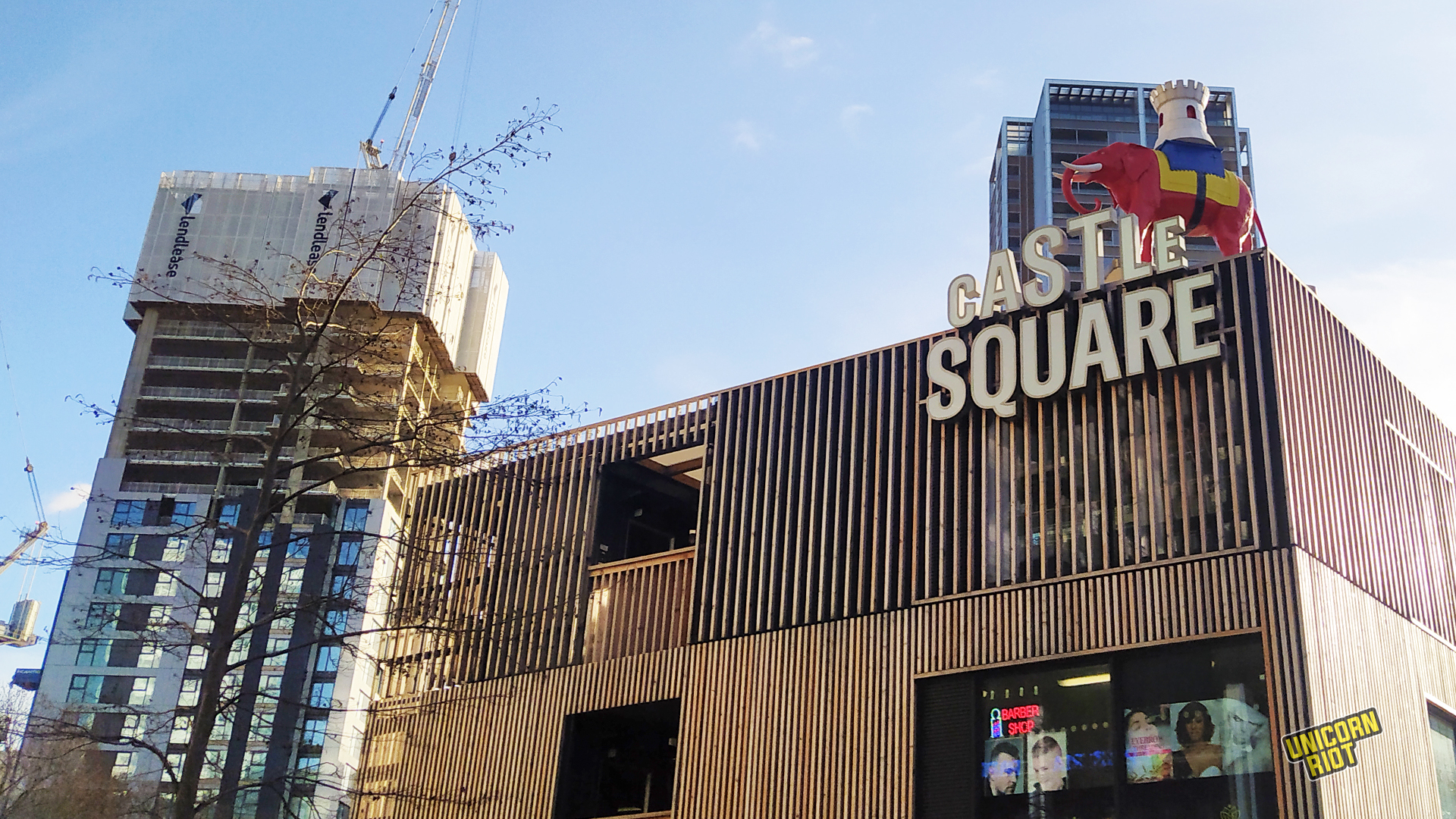Tale of the City: Gentrification in London – Part 1
Elephant and Castle: The Ground Zero of Gentrification in London
London, England — Gentrification has transformed the urban landscape of London’s Southwark Borough over the last decade. In the Elephant and Castle area, a district known for its squatting history, community networks and strong counterculture background, activists and political groups are now trying to reconnect struggles and reignite political movements calling for fair development. This article is the first in our three-part series, Tale of the City: Gentrification in London.
This series looks at three current struggles against gentrification across different boroughs of London — each containing threads of thought and action that intertwine in the city canvas presenting experience, education and perspective into explanations around the motives and definitions of gentrification. Relatedly, see our Gentrification in Greece series part one and two.
Read: The Tale of the City: Gentrification in London – Part 2 & Part 3
This article is a commentary piece reflecting lived experience, research and/or perspectives of the author. The views and opinions expressed don’t necessarily represent those of Unicorn Riot.
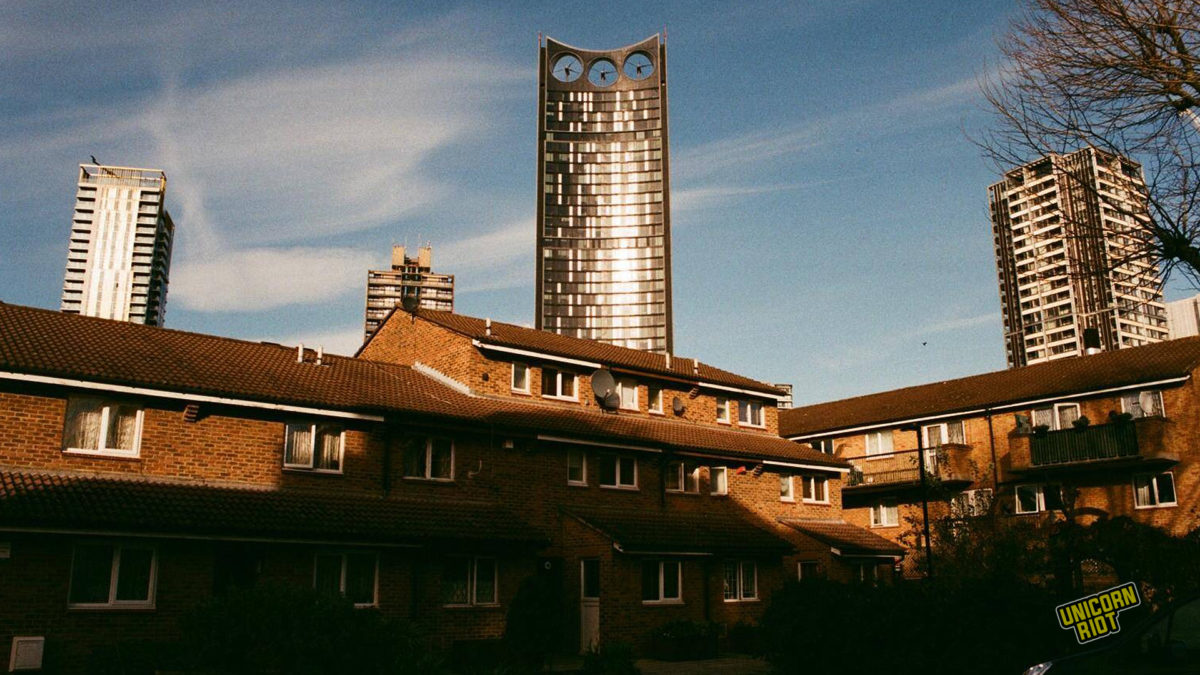
London Calling
“London’s calling but who’s listening,” was painted on the boat of an old Londoner who lived by the river and aligns perfectly with the repetitive sentence, “Sorry, but I’ll be a bit pessimistic.” The latter phrase left the mouth of nearly every person who tried to uncage their agony and speak about their city and everyday life in it. London has faced a number of challenges over the years, including economic disparities, housing shortages, social unrest, and environmental concerns.
In a visitor’s mind, this pessimism is an immediate contradiction to some of the greenest scenery in Europe with its many parks and green spaces throughout the city. A contradiction to the historic landmarks and monuments which are remnants of the aftermath of the city’s journey through the centuries, and to the multicultural poly-ethnic mosaic in the streets built in the days of an empire where the sun never set.
London has embarked into the uncharted waters of the high-tech, futuristic smart cities of tomorrow constituting a laboratory (like what Cambridge Analytica reveals, for example, in the reconstruction of Brexit under Nigel Farage’s guidance) and a practice field (like the panopticon and the excess of cameras hide behind ultimate control and surveillance) for the neoliberal realization of technology-based, aggressively-expanding-city-planning. Among others, it justifies its name as “city of money” with plenty of billionaires and tons of foreign capital invested in the metropolis every year.
On the other hand, London is one of the most linguistically diverse cities on earth. According to WorldAtlas, there are “thought to be more than 200 different languages spoken” in London at any given time. A global city where globality has a social, political and cultural meaning as well as its financial one, mostly known as globalization. It’s important to reclaim a positive sign for globality as a creative interaction between people, since globalization, especially after the anti-globalization movement in the end of the 90s, is considered to be merely a globalization of the markets and instead of triggering in the mind words as internationalism it bears threatening phrases like World Bank or the International Monetary Fund (IMF).
London has a long history of social, racial, and political struggles and a vast imprint of cultural avant-garde and counterculture. For many decades, the city constituted an undetermined experiment of grassroots or base-defined actions and proposals which explore the limits of the city and search for another example outside, and frequently against, the mainstream.
The topography of the city bears an antithesis, revealed by pockets of housing estates in wealthy areas as well as the opposite, ostentatious and luxury apartments in poorer boroughs. Two worlds collide repeatedly and continuously.
The austere bossy noise of the side of authority, echoing globally, attempts to define the result of this collision through speculation, legislation, and repression. Obviously the outcome will not be in favor of the many, of the basis and the have-nots, but instead it will aim to armor the few, the ‘critical mass’ that will ensure authority maintains its power (calling this mass through media propaganda a silent majority even if it’s a distinctive minority).
The 1%, or “the money,” as referred to by one Londoner after the economic crisis of 2008, remembered London again as a financial stronghold that should be enhanced with severe and intense interventions in the planning of the city and especially in housing. This shaped a condition of communities who couldn’t overcome, absorb or adjust to realities that they became conscious of retrospectively.
One of the main vehicles that authority uses for this raid on everyday life and housing is gentrification.
The term of gentrification was coined in the United Kingdom by sociologist Ruth Glass in 1964. This enhances semiologically the hypothesis that the City of London enables a deep elucidation of the phenomenon of gentrification due to the parallel existence of so many different types of it in a homogeneous environment.
This could raise the question of whether motives around gentrification can be defined, something that could allow timely and valid detection of it and perhaps effective ways to oppose it.
The city’s first gentrification instance took place in Elephant and Castle — we examine this district, known as ‘ground zero’ below.
The second area is in another borough of South London called Lambeth where the emblematic Brixton is located. The borough became a worldwide reference in the language of resistance through the 1981 riots and its cultural elixirs. Brixton is currently in a critical phase and is struggling not to lose its character entirely through the #FightTheTower campaign, which is aimed at stopping the construction of a 21-story building. Campaigners allege that the developers are attempting to evict the building’s ethnic minority residents.
The third example is in Tottenham’s Latin Village in the London Borough of Haringey of North London. The community there, through the Wards Corner Community Plan, tries not only to oppose gentrification but most importantly to propose another approach to community and city planning inside the urban tissue. More on the second and third instances in our upcoming specials.
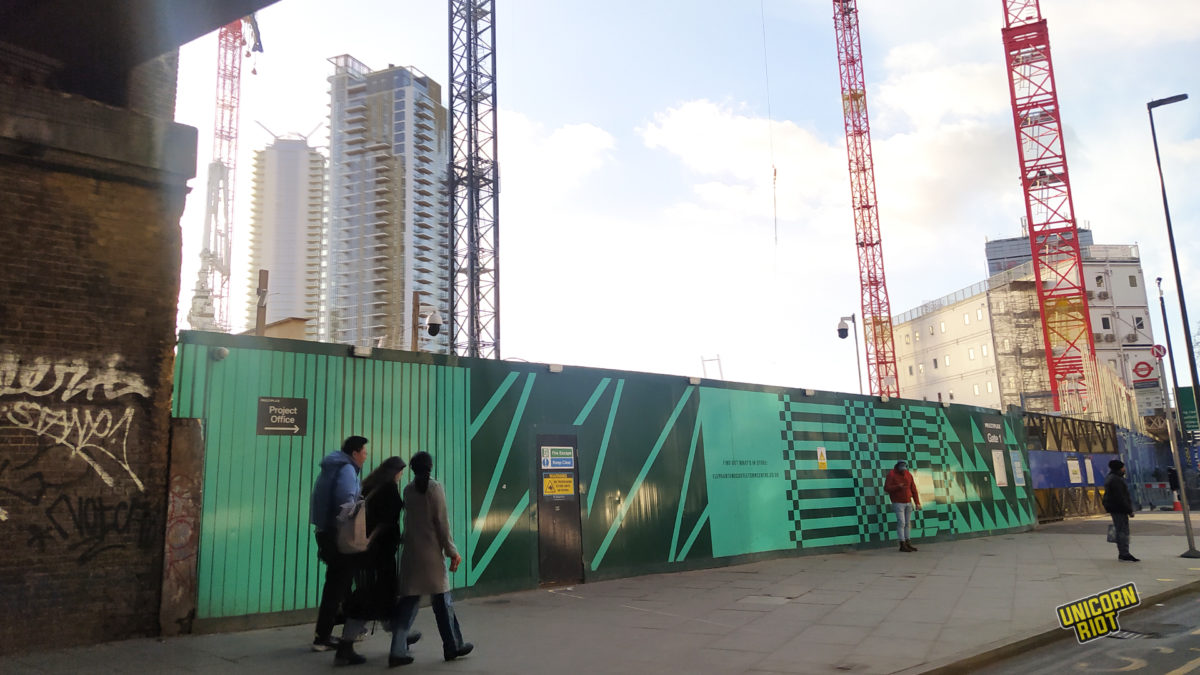
Welcome to Ground Zero
Elephant and Castle could be described as one of the most gentrified places in London. It’s located next to the River Thames and close to major financial hubs, the City of London and the City of Westminster. Elephant and Castle has a history of commercial and social activity which gave it the name Piccadilly of South London in the late 1920s.
As part of the post-World War II reconstruction metropolitan plan since the mid-1960s, Elephant and Castle has been reshaped into a diverse area with a strong Black community and a significant presence of Latin American communities, especially Colombians. The area has been called a ‘ground zero’ for gentrification in London due to its large-scale redevelopment over a very short period, giving rise to racial tensions.
There are three main aspects in Elephant and Castle that fuel the tensions — the vast number of council houses in the area, the demolitions of Heygate Estate in the early 2010s and the Elephant and Castle Shopping Center (ECSC) in 2021.
Council houses, housing estates, and cooperatives make up the social housing structure that shaped post-war London, establishing housing an accessible right for all, however decent or indecent the living conditions.
Elephant and Castle hosts an enormous amount of public houses. With 37,000 social rent homes, Southwark’s Council remains the largest social landlord in London. The number was much higher with around 60,000 units until 1980 when United Kingdom’s former Prime Minister Margaret Thatcher and the Tories Party (Conservative and Unionist Party) passed legislation that gave tenants the right to buy their council house from the local authorities. This was previously forbidden and acted as a defining policy for Thatcherism afterward.
The new property owning differentiation led to many houses being sold to people with no ties to the neighborhood and paved the way for real estate funds and developers to get their hands on a large number of public houses. Either through refurbishment or through speculation by leaving the houses empty, they then managed to raise the prices to unforeseen heights. A significant percentage of social housing was lost that way, with tenants being allowed by law to buy their public house at ten percent of its real value and then sell it at a later date on the private market for the full price in order to profit.
This brought a favorable wind to the Southwark Council which at that time was sailing in the Blairian third-way waters to craft avenues for heavy gentrification to enter the borough. They managed to put this in action in 2004 by adopting a regeneration plan for the area called A Development Framework for the Elephant and Castle.
The anti-gentrification magazine Southwark Notes hosts an excerpt of an essay by geographers James DeFillipis and Peter North which is indicative of the council’s intentions since 1999:
“Residents had to fight to get the regeneration programme to address their concerns … Community activists resolved to make Elephant Links a partnership led by local residents. They were concerned that the council was working to a hidden ‘social cleansing’ agenda. In an infamous remark, Southwark’s then Director of Regeneration, Fred Manson, argued that ‘We need to have a wider range of people living in the borough … social housing generates people on low incomes coming in and that generates poor school performances, middle class people stay away’. Southwark, it was argued, suffered from having too many of the ‘wrong sort’ of residents.”
The plan’s most highlighted points were the demolition of both Heygate Estate and the Elephant and Castle Shopping Center.
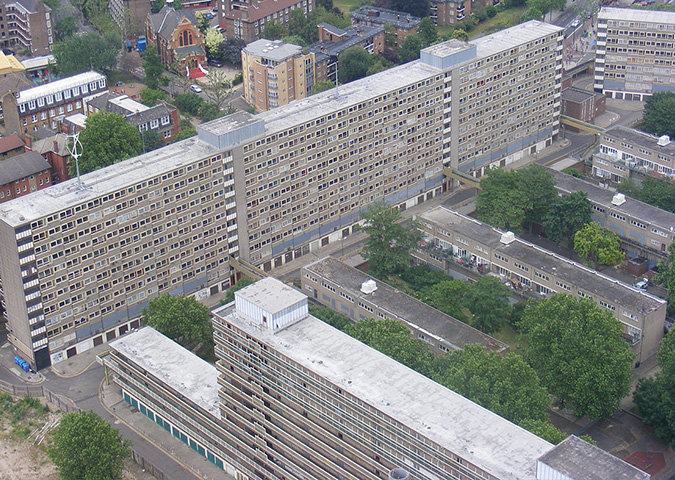
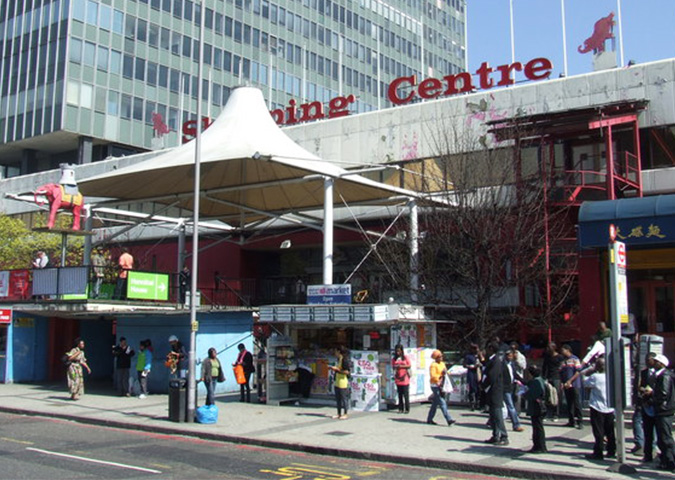
The Heygate Estate, built in 1974 with brutalist architecture, contained around 1,200 houses and was one of the most emblematic housing estates in London serving many times as a filming location, its last ‘role’ being the fictional estate Summerhouse in the drama TopBoy.
The fight against the demolition of Heygate marked one of the most important anti-gentrification struggles in London, which started in early 2000 and remained active until 2014. The movement deployed different tones of resistance driven by community mobilization, legal objections, demonstrations, and on occasion, militant tactics as what happened in 2013 when the bailiffs evicted the last remaining residents.
Despite the fight, the demolition of Heygate was completed by Lendlease (a global real-estate company headquartered in Australia) who took over the operation by the council, raising in its place the so-called Elephant Park, a development with a mix of private and public houses and a two-acre green space.
Around 4,000 public houses have been demolished altogether in recent years in the area and the council, which has 12,000 families on the housing waiting list, has promised 11,000 new council houses within the next 35 years.
This enhances the notion that spread all over London that younger people and families have no more access to buy property but only to rent, which strengthens corporate landlords even more.
This is amplified by the approach to the other significant victim of gentrification in the area, the ECSC, dictated by the erection of unreachable priced housing units even in previous market spaces.
The ECSC had been (in) the heart of the Elephant for 55 years, especially for the Latin community of the area, containing around 80 shops and services which were mostly independent and family-owned businesses run by locals.
Beyond its consumer characteristics, ECSC was the main social hub of the area, the place to socialize, catch a laugh, share a tear and feel all the peculiar funny or sad little things that constitute the everyday life of a community that is alive and thrives toward the best or the worst through time.
It was a local agora, a public space where a diverse local society was acting and creating, where British property development company Delancey, after buying the whole site in 2013, released a plan of 1,000 posh apartments that would be built in the center’s space among which only 33 would be public.
Within its short life span since 1995, Delancey has been caught up in the Panama Papers, the #CladdingScandal and a notorious partnership with Qatari Diar, a real estate company owned by the State of Qatar which is widely known for its democratic and human rights sensitivities.
The Up the Elephant campaign was formed to defend ECSC and try to put a brake on gentrification. The campaign had some hard battles but was victorious in raising the number of public houses-to-build from 33 to 166 and relocating some local traders to another place in the area.
However, finally, after the decision of the court of appeal, the legal fight against Delancey and Southwark Council was lost in 2021 and ECSC ceased to exist.
This full-frontal attack on the public space and the communities of Elephant and Castle is of utmost importance to analyze and reflect upon since it can be a blueprint for aggressive gentrification in the rest of London, As the activist Santiago Peluffo from the Latin Elephant, a registered charity set up to support ethnic minority traders at risk of displacement, pinpoints:
“The regeneration of Elephant and Castle will have a huge impact on other redevelopment projects across London because of the scale. But I also think it is because of the characteristics of the area; there is such a large BAME population, which is very diverse and, also, there is the matter of the demolition of two very large estates. I mean, they call it redevelopment, but it is actually something different. You really need to look closely, because it is a model for other [dispossession] projects. This is what I say when we give talks at conferences and round tables. I would advise communities and campaigns at risk of displacement to act as quickly as they can, bring the community to respond to the plans even before the developers submit the planning applications. What residents have had to endure with Lendlease, the private developer for the Heygate Estate, and Delancey for the shopping centre, has set a really bad precedent for other so called ‘opportunity areas’ across London.”
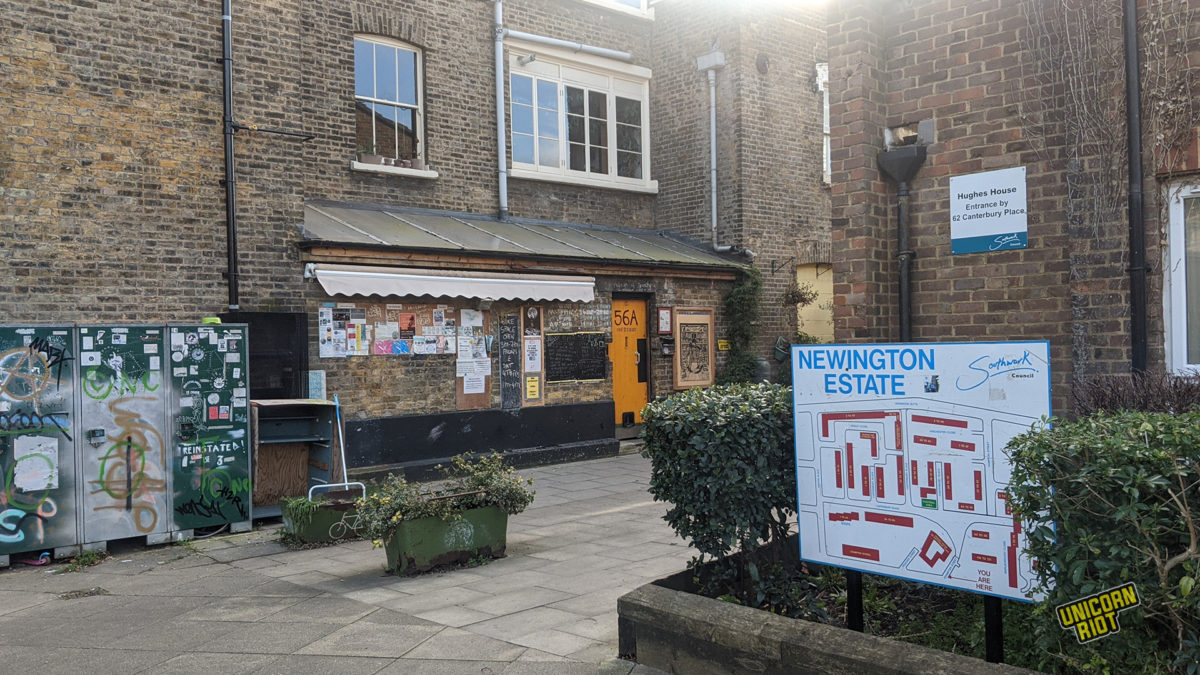
One of the real gems in the area is an infoshop named 56a which has been around since 1991. It has hosted an amazing political archive of books, zines and leaflets for various struggles mainly in the UK for over the last 50 years. That’s not all though, a food cooperative which counts 30 years of life and a bike space to fix your bike in a do-it-together mode every Wednesday and Friday also exist in 56a. Consistently and persistently, it has been contributing steadily as an ever-present participant to the political and social actions and events in the neighborhood.
The most precious inheritance of these struggles though are the community networks, the campaign meetings and actions, and all the valuable experience accumulated over years of struggle. According to the members of 56a, the struggles are mostly channeled through grassroots and neighborhood-centered initiatives and could be the needed fuel for the fight to go on and more victories to come.
The Infoshop has been contributing to the pursuit of a life worth living for the people of the Elephant who have lived the peaks of the counterculture, the pluralism of heterogeneous political and social tribes like punks and hippies, and other respectable citizens, and were baptized in the city through the uncanny universe of squats. Yes, Elephant was one of the boroughs with a high squatting fever.
New campaigns could not be absent in an area with such a rich political background, naming for example the Yes To Fair Development campaign or the Against Rooftop Development campaign opposing the council’s recent proposal to build more houses on the rooftops.
Gentrification appears to be a never-ending nightmare and communities seem to wake up inside it again and again even when they think it’s over. In the warmth of places like 56a where dreams are built, beautiful conspiracies are seamed on how the nightmare could be shattered. The lessons of the past dictate for the present initiatives which become loose of their liberal character and build a more radical one, with a neighborhood assembly-based horizontal approach, as well as a long-term aiming mobilization about gentrification.
Local disconnected events should give their place to the interaction with other struggles around the housing matter, like private renters or migrants, allowing that way to have fruitful results, not only in a discussion level as it fortunately happens lately, but also in action.
As long as there are seeds of political action there is hope, because seeds, however deep you bury them, they always find a way to grow and flourish. And these seeds, as we’ll see in the next parts about Brixton and Latin Village, have already made cracks in the concrete realities that gentrification endeavors to establish.
Part 2 – ‘When they kick at your front door…’ – Gentrification in Brixton
Part 3 – A village of hope in the city – Latin Village
Follow us on X (aka Twitter), Facebook, YouTube, Vimeo, Instagram, Mastodon, Threads, BlueSky and Patreon.

